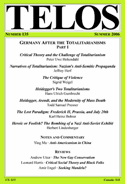Ramin Jahanbegloo, a leading proponent of Iranian democratization, has just been released from several months of incarceration in Teheran. Active in building bridges to Western intellectuals (including dialogues with Isaiah Berlin and George Steiner), Jahanbegloo—also a Canadian citizen—was arrested in April of this year at the Teheran airport on his way to a conference in Europe. Accusations included spying and efforts to pursue a US-inspired “Velvet Revolution” in Iran. Other accounts suggest that an interview he gave with a Spanish newspaper, critical of Ahmadenijad’s Holocaust denial, led to his arrest.
The release may represent an effort to pursue a minor distraction from the crisis over Iran’s nuclear technology. There is certainly no indication of a larger thaw. There may be some more complex ideological and tactical connection, discussed below. This is however an important opportunity to pursue the connections between “theory,” which is clearly Jahanbegloo’s passion, and the urgent political questions of the moment.
In his essay “Iranian Intellectuals: from Revolution to Dissent,” Jahanbegloo distinguishes between reformist/revolutionary and conservative forces. Note the intellectual genealogy of the conservatives of the Mullahocracy.
“Unlike the reformist intellectuals, the neo- conservative intellectuals in Iran are in favor of the supremacy of the Leader and against concepts such as democracy, civil society and pluralism. This movement includes figures such as Reza Davari Ardakani, Javad Larijani and Mehdi Golshani. The famous personality among these is Reza Davari Ardakani, who as an anti- Western philosopher is very familiar with the works of Martin Heidegger. Davari, unlike Soroosh, takes some of the features of Heidegger’s thought, mainly the critic of modernity and puts it into an Islamic wording. He rejects the Western model of democracy, which is based on the separation of politics and religion.”
Heidegger in Teheran as an account of anti-modernism? But beyond the dialectic of left and right from the generation of the Iranian revolution, Jahanbegloo describes a younger generation which approaches modernity from what appears to be a post-modern perspective: not post-modern in the sense of giddy relativism or irresponsibility but with liberal openness and an interest in dialogue.
 With the collapse of the Soviet Union and the end of the Cold War, a widespread rethinking of political history and social theory commenced. Questions long frozen in the glacial stand-off between East and West began to thaw out, and the ideological mythologies of the twentieth century were subjected to new scrutiny. Why had the century of modernity been so centrally catastrophic? What was the nature of the worst offenders, the totalitarian regimes—especially in Germany, Italy, and Russia—that had generated so much violence? How could intellectuals and public opinion alike have facilely regarded Nazi Germany and fascist Italy as nearly identical formations (when they displayed so many differences)? And how could Stalinist Russia have been hailed as a positive alternative to Nazi Germany (when they displayed so many similarities)? With the disappearance of the Soviet Union, these interrogations could be pursued without the agenda, baggage, and defensiveness of the previous historical era. The question of the totalitarian state could finally be posed with the advantage of historical distance..
With the collapse of the Soviet Union and the end of the Cold War, a widespread rethinking of political history and social theory commenced. Questions long frozen in the glacial stand-off between East and West began to thaw out, and the ideological mythologies of the twentieth century were subjected to new scrutiny. Why had the century of modernity been so centrally catastrophic? What was the nature of the worst offenders, the totalitarian regimes—especially in Germany, Italy, and Russia—that had generated so much violence? How could intellectuals and public opinion alike have facilely regarded Nazi Germany and fascist Italy as nearly identical formations (when they displayed so many differences)? And how could Stalinist Russia have been hailed as a positive alternative to Nazi Germany (when they displayed so many similarities)? With the disappearance of the Soviet Union, these interrogations could be pursued without the agenda, baggage, and defensiveness of the previous historical era. The question of the totalitarian state could finally be posed with the advantage of historical distance..






